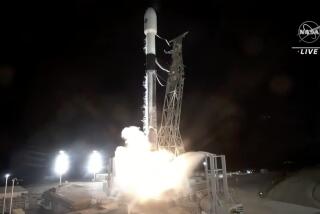Military Holds Disaster Won’t Hurt Space Plans : If Shuttle Flights Can Be Resumed Soon, It Hopes to Get by Temporarily With Unmanned Rockets
- Share via
WASHINGTON — Last month’s explosion of the space shuttle Challenger initially raised fears in the Pentagon that vital military space projects would be disrupted, but defense officials say they are now convinced that the tragic accident may have little lasting impact on their launching plans or on their use of space.
A senior-level Pentagon team is still studying the effect that the loss of one of the nation’s four space orbiters will have on their ability to deploy satellites and conduct experiments linked to the “Star Wars” project. But Air Force and other Pentagon officials believe that unmanned rockets will be able to carry out some of the work and that the existing shuttles--if returned to flight soon--can be counted on to help launch military payloads.
Ambitious Schedule
The Challenger accident occurred just as the Pentagon was starting an ambitious schedule of military flights, taking advantage of the shuttle’s massive lifting power and large cargo hold to boost American intelligence capabilities by sending heavy--and more sophisticated--satellites into orbit.
Although secrecy surrounds the Pentagon’s satellites, which can circle the globe every 90 minutes at an altitude of 200 miles or remain parked in one place above Earth, they are known to play major roles in electronic eavesdropping, navigation, communications with submarines, monitoring weapons tests, warnings of missile launchings and photo reconnaissance and the gathering of other intelligence used in such things as verifying compliance with arms control treaties.
The life of existing satellites varies, and at least one key reconnaissance satellite, the KH-11, is scheduled to be replaced by a more capable KH-12 sometime before its expected failure in 1987.
Shuttle Halted Indefinitely
When Challenger exploded on Jan. 28, killing the seven people aboard, the National Aeronautics and Space Administration declared an indefinite halt to all shuttle flights, throwing the Pentagon’s schedule into question.
Since then, according to Maj. Ron Rand, an Air Force spokesman, the Pentagon has maintained that “it’s too early to address the impact until we know how long the fleet will be grounded, what went wrong and what the fix will be.”
But other officials, speaking on the condition that they not be identified, say their initial concerns have abated, and they do not foresee major setbacks.
The busy military launching schedule included four flights dedicated to mostly classified military cargo in the current fiscal year, including the first shuttle launching from Vandenberg Air Force Base in California. But, even before the explosion, that plan had slipped to three flights.
Under arrangements for sharing the shuttles’ cargo holds worked out by NASA and the Air Force, the military may cite national security considerations to claim top priority on cargo space on a shuttle flight. But such a step would bump commercial customers from the flight--an expensive action that NASA would prefer to avoid.
‘Front of the Line’
“When they start flying stuff, the military will be at the front of the line,” predicted John Pike, associate director of the Federation of American Scientists and a specialist on the issue of space weapons.
The first question Pentagon officials are waiting to have answered, of course, is how long NASA will keep the orbiters on the ground. They say that a six-month delay can be overcome, but a two-year delay involving redesign of the shuttle and tests of new equipment would be much less manageable.
And, although the overall schedule remains uncertain, officials said that, if NASA’s freeze on shuttle launchings is held to six months, the flight from the new Vandenberg launching pad could take place in July, as planned before the disaster.
Defense Secretary Caspar W. Weinberger told the Senate Budget Committee last week that the Pentagon has yet to reach “definitive conclusions” about the effect the disaster will have on the military but that it was studying the possibility of taking missiles out of storage to launch some satellites.
Favors New Shuttle
He has also said he favors building a new shuttle, and he told an audience in Detroit just two days after the explosion: “I think we need that capability.”
But such an endeavor would cost at least $2 billion, officials have said, and would take at least three and, possibly, four years to complete. Pentagon officials said that that decision must be made by space agency officials and others in the Administration.
The fleet of missiles available for lifting satellites includes, among others, seven Titan 34-Ds and 15 Atlases, plus 11 smaller Scout missiles capable of lifting only 2,000-pound payloads into near-Earth orbits.
The Air Force has been using such unmanned vehicles to send satellites aloft without much attention in recent years, conducting 35 launchings since the first shuttle flight in 1981.
However, these missiles do not have the capabilities of the shuttle, which is designed to protect a sensitive, electronically sophisticated cargo from the heat and shock of launching.
AF Building Titans
After a lengthy fight, the Air Force and NASA accepted an arrangement, made formal by a directive from President Reagan, under which the Pentagon would continue to use the shuttle, but the Air Force would be allowed to build 10 Titan 34-D7 missiles--modified Titan 34-Ds designed to duplicate some of the capacities of the shuttle while being available for almost immediate launching.
The unmodified Titan can send a 5,000-pound satellite into a geosynchronous orbit nearly 23,000 miles above the earth or a 10,000-pound satellite into a lower orbit.
However, the first of these new missiles will not be available until 1988.
More to Read
Sign up for Essential California
The most important California stories and recommendations in your inbox every morning.
You may occasionally receive promotional content from the Los Angeles Times.










